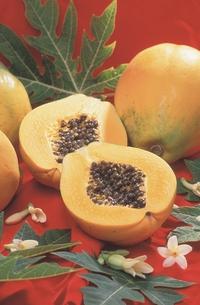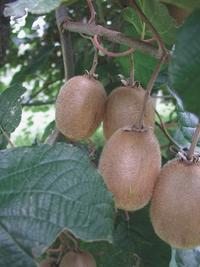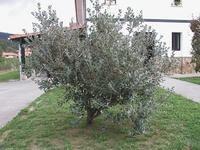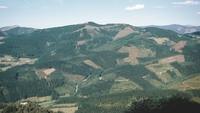Tropical fruits here

the consumption of tropical or exotic fruits in the Basque Country has grown uninterrupted. Until a few years ago, many of the fruits from the tropics were practically unknown. These were luxury products that were only consumed on special days, such as Christmas holidays.
The largest supply of tropical fruits on the market remains at Christmas. At the fair, on many occasions, only at this time you can buy carambolas, litchis, maracuyas or physalis. Other tropical fruits, however, are on the market throughout the year. Among them are coconut, kiwi, chirimón, mango, papaya, pineapple...
However, not all tropical fruits are new here. Banana, for example, is one of the most eaten fruits, after oranges and apples. Others are known recently, but more and more are consumed, such as kiwi. In addition, kiwi is also produced here, as the plant is well adapted to the climate and soil here.
Kiwi euskaldun

Kiwi is the exotic fruit that grows the most in Euskal Herria. Originally from China, it belongs to the Yang-Tse-Kiang River Valley. Its climate is humid subtropical and the plant grows along the rivers winding around the trees.
The wild plant was domesticated in New Zealand and its powerful multinationals promoted fruit consumption and plant sale. At that time he arrived in Euskal Herria in the 1970s, but until the 1980s they did not begin to grow in Bizkaia and Gipuzkoa.
The plant needs a temperate temperature, 5-15ºC in winter and 14-25ºC in summer. It requires plenty of water, wet atmosphere and enough light. In addition, frost and wind do a lot of damage. Frosts are especially dangerous when the plant is in times of sprouts (from mid-March to the end of April) and in times of fruit collection (first fortnight of November). Therefore, some coastal areas are the most suitable for kiwi growth.
In these areas they planted, so even though the kiwi and plant were expensive, the producers had benefits, since the fruit was also sold expensive. But consumers were willing to pay.
Ramón Amenábar, from the Department of Agriculture of the Provincial Council of Bizkaia, has continued since its inception the evolution of kiwi in the Basque Country and, in his opinion, "the propaganda made by New Zealand companies had a great influence on the attitude of consumers. They released the fruit. Being C a source of unparalleled vitamins, which served to prevent catarros, which was very good against constipation... and that's why people started buying kiwi."

Productive if taken care of
So, at that time plantations were made there and here, but not anywhere. In addition to the climate there is another factor to consider, the land. In the humid Basque Country, most lands are clayey, and although kiwi needs a lot of water, its roots should not be in water.
In clay soil or clay limes the water does not leak, wells remain. In this soil do not develop the roots of the kiwi plant, since they lack oxygen. This makes the plant not grow well and give few fruits, with the danger of rotting the roots and neck and losing the plant.
To avoid this, once the study of the soil is done, it is necessary to drain the soil in some areas. In the planting of kiwi, in addition to the type of terrain, other aspects must be taken into account. The fruit culture consultant, Aitor Etxeandia, said that "if the land does not contain much organic matter, organic fertilizers and even minerals are necessary, especially nitrogen, phosphorus and potassium. On the other hand, once the earth is conditioned, supports for the vegetation will be placed, so that it grows around them. And in some cases it is convenient to install protection systems against wind, freezing or hail."

Otherwise, the plant does not require special care. If you have adequate soil, enough water and hours of sunshine, it grows well and gives a lot of fruit. If you have too much fruit some intermediates are removed, otherwise they are small and the same happens if you do not have enough water.
As for diseases, he has no problems, but Etxeandia has warned that "now has begun to explain a disease: dry the stem or branch. It is similar to what happens with the vine and seems to be formed by a group of fungi. The problem is that the wood dries and dies. To avoid it, in addition to the treatment of the plant, it is necessary to disinfect the tools to prevent the spread of the disease".
Tropical Euskadi, not yet
Despite healthy and fertile plants, kiwi production is not as profitable as before. The price has fallen a lot in the market and it is difficult to reduce the cost. In other countries, production is cheaper than here, thanks to machining or cheap labour. Therefore, the kiwi has not had the success that some expected in the beginning.
According to Amenabar, although the most cultivated tropical fruit is kiwi, "success is not so much. In Bizkaia there are between 45 and 50 hectares, in Gipuzkoa there are many others, in Navarra too and in Iparralde between 20 and 30 hectares. In total there will be about 200 hectares, and that is nothing. Look at the pine insignis: Only 150,000 hectares exist in the Autonomous Community of the Basque Country."

The other tropical fruits are even scarcer. Due to the good adaptation of kiwi, other tropical fruits have been tested. But they have not been very successful. For example, in the Fuero of Bizkaia one tried with the allubia. Originally from Ecuador and Colombia. Its appearance is similar to a cucumber, sweet taste and high fertility. They tested it in the greenhouse and gave it very well. However, they stopped producing because it was not sold.
Precisely, Amenábar is clear that it is very difficult for a new product to succeed in the market if it is not pushed from behind. Kiwi was driven by powerful multinationals and well received by consumers. However, bean did not have this type of aid and the plantations were abandoned.
Like Baba's, feijo grows very well in many places in the Basque Country. Coming from New Zealand, it is a beautiful tree with spectacular flowers. It is a very aromatic and sweet fruit that has not been successful in the market either. Thus, existing isolated plants are used to decorate portals and have fruit for the home. In fact, both feijo and other fruit trees already existed in Euskal Herria, brought by the Indians. In Iparralde, for example, there are a few bananas in front of the houses of the Indians.
Experts do not believe that among here other tropical fruits. In Etxeandia's opinion, "if you do a lot in the place of origin, it is not worth producing it here, since you would have to sell less than it costs. Bear in mind that there is no agricultural land here. The Earth is very expensive and agriculture is sinking. In addition, it would be necessary to do a study to know if a certain species adapts or not, but I do not think it is worth it. Keeping what is done today." Far away is the tropical Basque Country, the company.
Buletina
Bidali zure helbide elektronikoa eta jaso asteroko buletina zure sarrera-ontzian











